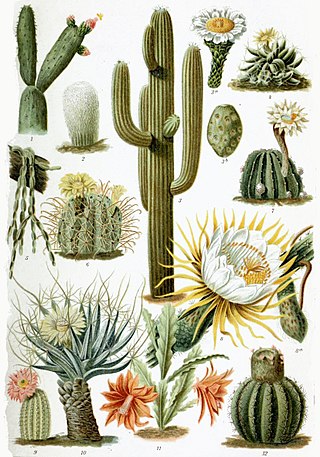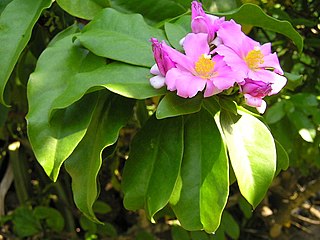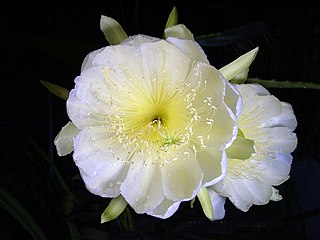
A cactus is a member of the plant family Cactaceae, a family comprising about 127 genera with some 1,750 known species of the order Caryophyllales. The word cactus derives, through Latin, from the Ancient Greek word κάκτος (káktos), a name originally used by Theophrastus for a spiny plant whose identity is now not certain. Cacti occur in a wide range of shapes and sizes. They are native to the Americas, ranging from Patagonia in the south to parts of western Canada in the north, with the exception of Rhipsalis baccifera, which is also found in Africa and Sri Lanka. Cacti are adapted to live in very dry environments, including the Atacama Desert, one of the driest places on Earth. Because of this, cacti show many adaptations to conserve water. For example, almost all cacti are succulents, meaning they have thickened, fleshy parts adapted to store water. Unlike many other succulents, the stem is the only part of most cacti where this vital process takes place. Most species of cacti have lost true leaves, retaining only spines, which are highly modified leaves. As well as defending against herbivores, spines help prevent water loss by reducing air flow close to the cactus and providing some shade. In the absence of true leaves, cacti's enlarged stems carry out photosynthesis.

Echinopsis is a genus of cacti native to South America, sometimes known as hedgehog cactus, sea-urchin cactus or Easter lily cactus. As of October 2023, there are about 20 accepted species, ranging from large and treelike types to small globose cacti. The name derives from echinos hedgehog or sea urchin, and opsis appearance, a reference to these plants' dense coverings of spines.

Pereskia is a small genus of about four species of cacti that do not look much like other types of cacti, having substantial leaves and non-succulent stems. The genus is named after Nicolas-Claude Fabri de Peiresc, a 16th-century French botanist. The genus was more widely circumscribed until molecular phylogenetic studies showed that it was paraphyletic. The majority of species have since been transferred to Leuenbergeria and Rhodocactus. Although Pereskia does not resemble other cacti in its overall morphology, close examination shows spines developing from areoles, and the distinctive floral cup of the cactus family.

Epiphyllum is a genus of epiphytic plants in the cactus family (Cactaceae), native to Central America and South America. Common names for these species include climbing cacti, orchid cacti and leaf cacti, though the latter also refers to the genus Pereskia.

Neoraimondia is a genus of medium to large cacti from Peru. The genus is named after the Italian-born Peruvian explorer, naturalist, and scientist, Antonio Raimondi.

Selenicereus, sometimes known as moonlight cactus, is a genus of epiphytic, lithophytic, and terrestrial cacti, found in Mexico, Central America, the Caribbean and northern South America. The term night-blooming cereus is also sometimes used, but this is also used for many night-blooming cacti, including Epiphyllum and Peniocereus. In 2017, the genus Hylocereus was brought into synonymy with Selenicereus. A number of species of Selenicereus produce fruit that is eaten. The fruit, known as pitaya or pitahaya in Spanish or as dragon fruit, may be collected from the wild or the plants may be cultivated.

Rhipsalis is a genus of epiphytic flowering plants in the cactus family, typically known as mistletoe cacti. They are found in parts of Central America, the Caribbean and northern regions of South America. They also inhabit isolated locations in Africa and Asia, and are the only cactus group naturally occurring in the Old World. This is the largest and most widely distributed genus of epiphytic cacti.

Discocactus is a genus of tropical cacti. Discocactus plants are endemic to southern Brazil, eastern Bolivia, and northern Paraguay. These species are in the risk of extinction in the wild.

Haageocereus is a genus of cacti endemic to the lower elevations of the extremely dry desert along the coast of Peru and northern Chile.

Mila caespitosa is a species of cacti and the only species of the genus Mila. Its generic name is an anagram of Lima, Peru, the city near which the plant is found. The genus was first thought to comprise 13 species, until recent studies suggest they form one very variable species.

Weingartia is a genus in the family Cactaceae, with species native to Bolivia and Argentina. Molecular phylogenetic evidence suggests that it may be distinct from Rebutia. It is treated as a synonym of that genus by Plants of the World Online as of September 2023, but recognized as an alternative generic name in the third edition of the CITES Cactaceae Checklist. It may also be treated as Rebutia subg. Weingartia.

Pereskiopsis is a genus of cactus in the subfamily Opuntioideae. Unlike typical cacti, it has persistent fleshy leaves. The genus name refers to its resemblance to the genus Pereskia. Most species are found in Mexico south through Guatemala to Honduras, with one species in Bolivia. The incorrect spelling Peireskiopsis has also been used.

Rhodocactus is a genus of flowering plant in the cactus family Cactaceae, native to central South America. Unlike most species of cacti, Rhodocactus has persistent leaves and a fully tree-like habit. The genus was sunk into a broadly circumscribed Pereskia, but molecular phylogenetic studies from 2005 onwards showed that with this circumscription Pereskia was paraphyletic, and in 2016, Rhodocactus was restored for southern South American species.

Selenicereus megalanthus, synonym Hylocereus megalanthus, is a cactus species in the genus Selenicereus that is native to northern South America, where it is known, along with its fruit, by the name of pitahaya. The species is grown commercially for its yellow fruit, but is also an impressive ornamental climbing vine with perhaps the largest flowers of all cacti.

Lophocereus marginatus is a species of plant in the family Cactaceae. It is sometimes called Mexican fencepost cactus.

Cereus ( "serious") is a genus of cacti including around 33 species of large columnar cacti from South America. The name is derived from Greek (κηρός) and Latin words meaning "wax", "torch" or "candle". Cereus was one of the first cactus genera to be described; the circumscription varies depending on the authority. The term "cereus" is also sometimes used for a ceroid cactus, any cactus with a very elongated body, including columnar growth cacti and epiphytic cacti.

The Hylocereeae are a tribe of cacti. Most are found in the tropical forests of Central and northern South America, and are climbers or epiphytes, unlike most cacti. The tribe includes between six and eight genera in different circumscriptions. The plants known as "epiphyllum hybrids" or "epiphyllums", widely grown for their flowers, are hybrids of species within this tribe, particularly Disocactus, Pseudorhipsalis and Selenicereus, less often Epiphyllum, in spite of the common name.

Lophocereus schottii, the senita cactus, is a species of cactus from southern Arizona and north-western Mexico, particularly Baja California and Sonora.

Pachycereus pecten-aboriginum is a columnar cactus plant native to Mexico. They can grow up to 15 m (49 ft) high. The trunk of this species is 1.2 to 5.0 m tall and the fruits are large and burr-like. The specific name, pecten-aboriginum, is from the Latin, and means "native combs". It was inspired by the use of the fruits as hair combs.

Leuenbergeria is a genus of flowering plant in the family Cactaceae, mostly native around the Caribbean. Unlike most cacti, it has persistent leaves and develops bark on its stems early in its growth. The genus was created in 2012 by Joël Lodé. Before the creation of Leuenbergeria as a genus, the species within it were included in a broadly circumscribed genus, Pereskia. Leuenbergeria is the only genus in the subfamily Leuenbergerioideae.























